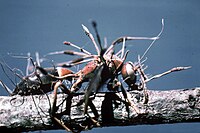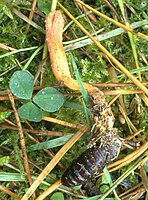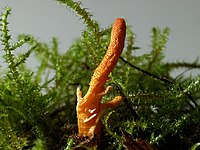Cordyceps
| Cordyceps | |
|---|---|

| |
| Cordyceps militaris | |
| Scientific classification | |
| Domain: | Eukaryota |
| Kingdom: | Fungi |
| Division: | Ascomycota |
| Class: | Sordariomycetes |
| Order: | Hypocreales |
| Family: | Cordycipitaceae |
| Genus: | Cordyceps Fr. (1818) |
| Type species | |
| Cordyceps militaris (L.) Fr. (1818)
| |
| Synonyms | |
|
List
| |
Cordyceps /ˈkɔːrdɪsɛps/ is a genus of ascomycete fungi (sac fungi) that includes about 750 species worldwide, 200 of these species are parasitic. Diverse variants of cordyceps have had more than 1,500 years of use in Chinese medicine.[1] Most Cordyceps species are endoparasitoids, parasitic mainly on insects and other arthropods (they are thus entomopathogenic fungi); a few are parasitic on other fungi.[2]
The generic name Cordyceps is derived from the ancient Greek κορδύλη kordýlē, meaning "club", and the Latin -ceps, meaning "-headed".[3] The genus has a worldwide distribution, with most of the known species[4] being from Asia.
Taxonomy
There are two recognized subgenera:[5]
Cordyceps sensu stricto are the teleomorphs of a number of anamorphic, entomopathogenic fungus "genera" such as Beauveria (Cordyceps bassiana), Septofusidium, and Lecanicillium.[8]
Splits
Cordyceps subgen. Epichloe was at one time a subgenus, but is now regarded as a separate genus, Epichloë.[5]
Cordyceps subgen. Ophiocordyceps was at one time a subgenus defined by morphology. Nuclear DNA sampling done in 2007 shows that members, including "C. sinensis" and "C. unilateralis", as well as some others not placed in the subgenus, were distantly related to most of the remainder of species then placed in Cordyceps (e.g. the type species C. militaris). As a result, it became its own genus, absorbing new members.[8][9]
The 2007 study also peeled off Metacordyceps (anamorph Metarhizium, Pochonia) and Elaphocordyceps. A number of species remain unclearly assigned and provisionally retained in Cordyceps sensu lato.[8]
Species

The following species are recognised in the genus Cordyceps:[10]
- Cordyceps adpropinquans (Ces.) Sacc. 1883
- Cordyceps agriotidis Kawam. 1955
- Cordyceps albella Massee 1899
- Cordyceps albida Berk. & M.A. Curtis ex Cooke 1884
- Cordyceps aspera Pat. 1893
- Cordyceps atrobrunnea Penz. & Sacc. 1898
- Cordyceps baumanniana Henn. 1897
- Cordyceps brasiliensis Henn. 1897
- Cordyceps caespitosa (Tul. & C. Tul.) Sacc. 1878
- Cordyceps callidii Quél. 1898
- Cordyceps caroliniensis Berk. & Ravenel 1855
- Cordyceps chongqingensis Y.H. Yang, Shao X. Cai, Y.M. Zheng, X.M. Lu, X.Y. Xu & Y.M. Han 2008
- Cordyceps citrea Penz. & Sacc. 1898
- Cordyceps coxii Olliff 1895
- Cordyceps cranstounii Olliff 1895
- Cordyceps cusu Pat. 1895
- Cordyceps deflectens Penz. & Sacc. 1898
- Cordyceps dennisii T. Ulvinen 1976
- Cordyceps doassansii Pat. 1885
- Cordyceps fasciculata Pat. 1899
- Cordyceps formosana Kobayasi & Shimizu 1981
- Cordyceps fuliginosa Ces. 1861
- Cordyceps grylli Teng 1936
- Cordyceps hackmannii Rehm 1904
- Cordyceps hawkesii G.R. Gray 1858
- Cordyceps hehuanensis W.Y. Chuang & Ariyaw. 2024
- Cordyceps henleyae Massee 1894
- Cordyceps herculea (Schwein.) Sacc. 1883
- Cordyceps herculea (Cooke) Mussat 1901
- Cordyceps huntii Giard 1895
- Cordyceps isarioides M.A. Curtis 1895
- Cordyceps javanica Bally 1923
- Cordyceps koratensis (Hywel-Jones) Ariyaw., M. Stadler & Luangsa-ard 2024
- Cordyceps kyusyuensis Kawam. 1955
- Cordyceps langloisii Ellis & Everh. 1892
- Cordyceps lignicola Massee 1899
- Cordyceps locastrae W.Y. Chuang & Ariyaw. 2024
- Cordyceps malleiformis W.Y. Chuang & Ariyaw. 2024
- Cordyceps miquelii (Tul. & C. Tul.) Sacc. 1883
- Cordyceps mitrata Pat. 1898
- Cordyceps montagnei Berk. & M.A. Curtis 1869
- Cordyceps muscae Henn. 1898
- Cordyceps nakazawae Kawam. 1955
- Cordyceps norvegica Johan-Olsen 1911
- Cordyceps odyneri Quél. 1886
- Cordyceps oncoperae P.J. Wright 1993
- Cordyceps oumensis Höhn. 1909
- Cordyceps pieli Olliff 1895
- Cordyceps pittieri E. Bommer & M. Rousseau 1896
- Cordyceps pseudorosea W.Y. Chuang & Ariyaw. 2024
- Cordyceps puiggarii Speg. 1918
- Cordyceps racemosa Berk. 1854
- Cordyceps rostrata Z.Q. Liang, A.Y. Liu & M.H. Liu 2003
- Cordyceps scottianus Olliff 1895
- Cordyceps setulosa Quél. 1875
- Cordyceps sheeringii Massee 1890
- Cordyceps siangyangensis W.Y. Chuang & Ariyaw. 2024
- Cordyceps submilitaris Henn. 1896
- Cordyceps trictenae Olliff 1895
- Cordyceps typhuliformis Berk. & Cooke 1884
- Cordyceps velutipes Massee 1895
- Cordyceps wallaysii Westend. 1859
Biology
When Cordyceps attacks a host, the mycelium invades and eventually replaces the host tissue, while the elongated fruit body (ascocarp) may be cylindrical, branched, or of complex shape. The ascocarp bears many small, flask-shaped perithecia containing asci. These, in turn, contain thread-like ascospores, which usually break into fragments and are presumably infective.[11]
Research

Polysaccharide components and the nucleoside cordycepin isolated from C. militaris are under basic research, but more advanced clinical research has been limited and too low in quality to identify any therapeutic potential of cordyceps components.[12]
Uses
Along with Ophiocordyceps, Cordyceps has long been used in traditional Chinese medicine in the belief it can be used to treat diseases.[13] There is no strong scientific evidence for such uses.[12]
Cultural representations
The video game series The Last of Us (2013–present) and its television adaptation present Cordyceps as a deadly threat to the human race, its parasitism powerful enough to result in global calamity.[14][15] The result is a zombie apocalypse and the collapse of human civilization. Scientific American notes that some species in the genus "are indeed body snatchers–they have been making real zombies for millions of years", though of ants or tarantulas, not of humans.[14] The Last of Us proceeds from the premise that a new species of Cordyceps manages to jump between species of host, just as diseases like influenza have done. Its human hosts initially become violent "infected" beings, before turning into blind zombie "clickers", complete with fungal "fruiting bodies sprouting from their faces".[14] In an additional detail that reflects Cordyceps biology, "clickers" then seek out a dark place in which to die and release the fungal spores, enabling the parasite to complete its life cycle.[14] Scientific American comments that by combining a plausible mechanism with effective artistic design, the series gains "both scientific rigor and beauty".[14]
In similar vein, Cordyceps causes a pandemic that wipes out most of humanity in Mike Carey's 2014 postapocalyptic novel The Girl with All the Gifts and its 2016 film adaptation.[16] In this case, an infected person becomes a "hungry", a zombie thirsting for blood. In the fiction, Dr. Caldwell explains that the human-infecting fungus is a mutated form of Ophiocordyceps unilateralis (a group of species now split off from Cordyceps) which alters the behaviour of infected insects. The children of infected mothers, however, become "hybrids" with antibodies protecting them against the fungus.[16]
Gallery
-
Cordyceps beginning its fruiting growth from a wasp
-
Cordyceps militaris
-
Cordyceps militaris
See also
References
- ^ Buenz, E. J.; B. A. Bauer; Osmundson, T. W. & Motley, T. J. (2005). "The traditional Chinese medicine Cordyceps sinensis and its effects on apoptotic homeostasis". Journal of Ethnopharmacology. 96 (1–2): 19–29. doi:10.1016/j.jep.2004.09.029. PMID 15588646.
- ^ Nikoh, N (April 2000). "Interkingdom host jumping underground: phylogenetic analysis of entomoparasitic fungus of the genus cordyceps". Mol Biol Evol. 17 (4): 629–38. doi:10.1093/oxfordjournals.molbev.a026341. PMID 10742053.
- ^ "Cordyceps". www.merriam-webster.com. Retrieved 22 August 2023.
- ^ Sung, Gi-Ho; Nigel L. Hywel-Jones; Jae-Mo Sung; J. Jennifer Luangsa-ard; Bhushan Shrestha; Joseph W. Spatafora (2007). "Phylogenetic classification of Cordyceps and the clavicipitaceous fungi". Studies in Mycology. 57 (1): 5–59. doi:10.3114/sim.2007.57.01. PMC 2104736. PMID 18490993.
- ^ a b "Cordyceps". Index Fungorum. Retrieved 4 September 2019.
- ^ Elias Magnus Fries, Observ. mycol. (Havniae) 2: 316 (cancellans) (1818)
- ^ Edmond Tulasne & Charles Tulasne, Select. fung. carpol. (Paris) 3: 20 (1865)
- ^ a b c Sung, GH; Hywel-Jones, NL; Sung, JM; Luangsa-Ard, JJ; Shrestha, B; Spatafora, JW (2007). "Phylogenetic classification of Cordyceps and the clavicipitaceous fungi". Studies in Mycology. 57: 5–59. doi:10.3114/sim.2007.57.01. PMC 2104736. PMID 18490993.
- ^ Holliday, John; Cleaver, Matt (2008). "Medicinal Value of the Caterpillar Fungi Species of the Genus Cordyceps (Fr.) Link (Ascomycetes). A Review" (PDF). International Journal of Medicinal Mushrooms. 10 (3). New York: Begell House: 219–234. doi:10.1615/IntJMedMushr.v10.i3.30. ISSN 1521-9437. Archived from the original (PDF) on 22 February 2012. Retrieved 10 March 2009.
- ^ "Index Fungorum - Search Page". www.indexfungorum.org. Retrieved 6 November 2024.
- ^ Shrestha, Bhushan; Han, Sang-Kuk; Sung, Jae-Mo; Sung, Gi-Ho (2012). "Fruiting Body Formation of Cordyceps militaris from Multi-Ascospore Isolates and Their Single Ascospore Progeny Strains". Mycobiology. 40 (2): 100–106. doi:10.5941/MYCO.2012.40.2.100. ISSN 1229-8093. PMC 3408298. PMID 22870051.
- ^ a b "Cordyceps". Drugs.com. 12 July 2023. Retrieved 15 September 2023.
- ^ "Chinese Medicine Specimen Database". libproject.hkbu.edu.hk. Retrieved 6 March 2023.
- ^ a b c d e Hill, Kyle (25 June 2013). "The Fungus that Reduced Humanity to The Last of Us". Scientific American. Retrieved 4 May 2021.
- ^ D'Addario, Daniel (10 January 2023). "'The Last of Us,' From 'Chernobyl's' Craig Mazin, Is a Promising, Moving Zombie Saga: TV Review". Variety. Retrieved 15 February 2023.
- ^ a b Bachman, Mara (12 April 2020). "The Girl With All The Gifts: Fungal Infection & Hungries Explained". ScreenRant. Retrieved 23 October 2023.




